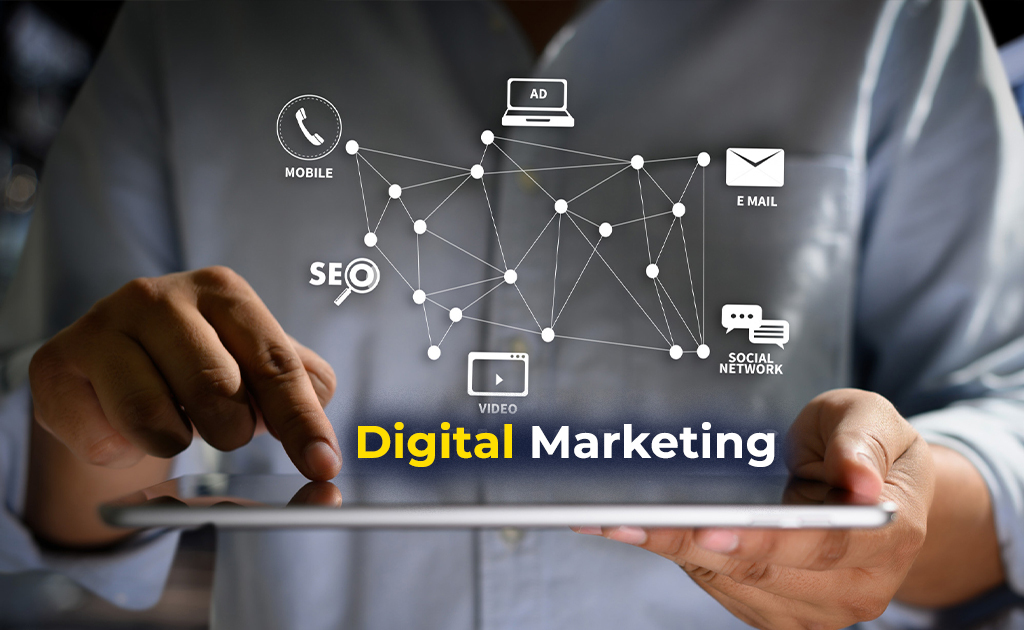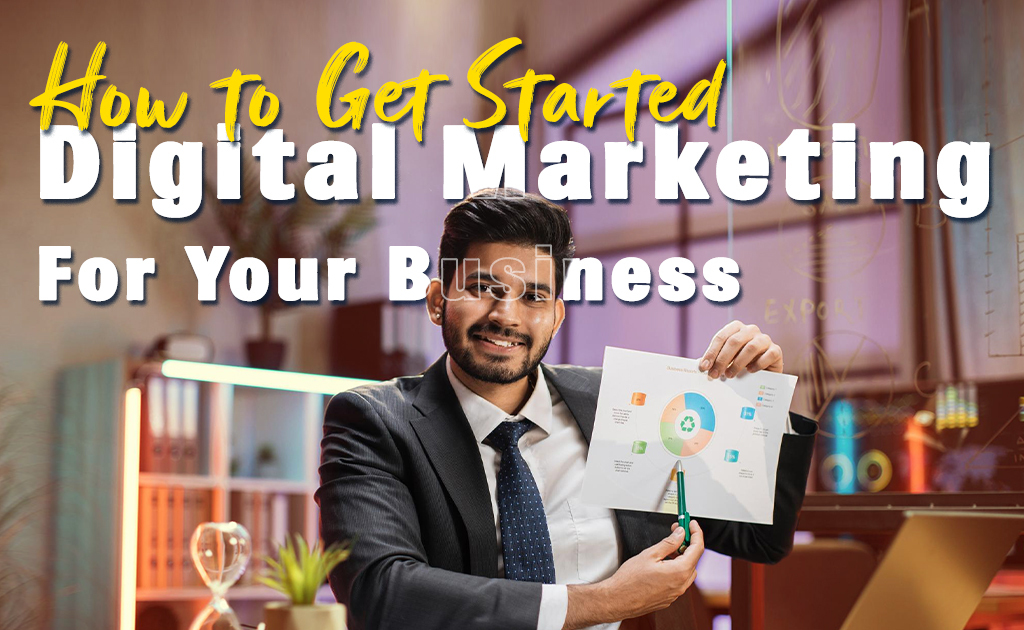Introduction: Why Digital Marketing Is Non-Negotiable for Modern Businesses
These days, your business needs more than a signboard—it needs a screen presence. Whether you’re a solo entrepreneur, a local service provider, or managing a growing small business, reaching your target audience online is the key to staying relevant and competitive.
Consider this: over 81% of consumers research online before making a purchase decision. That means if your business isn’t visible online, you’re missing out on a massive share of potential customers.
Digital marketing for business isn’t just an option—it’s a growth engine. From increasing brand awareness and generating qualified leads to building lasting customer relationships, digital strategies open doors that traditional marketing alone cannot.
With over a decade of experience guiding small and mid-sized businesses through digital transformations, our team has seen firsthand the measurable impact of a well-executed digital marketing strategy. Whether you’re just starting out or seeking to upgrade your existing efforts, this guide offers a step-by-step roadmap grounded in expertise and actionable advice.
Table of Contents
What Is Digital Marketing for Business?

Digital marketing for business refers to the use of digital channels, tools, and tactics to promote a product or service online. It encompasses everything from websites and email to social media, search engines, and online advertising. But more than just tactics, it’s a strategic approach to meeting your business goals by engaging with your target audience where they spend most of their time—online.
Here are some of the primary channels that make up digital marketing:
- Search Engine Optimization (SEO): Improving your website’s visibility in search results.
- Social Media Marketing: Building a presence on platforms like Facebook, Instagram, LinkedIn, and more.
- Content Marketing: Creating blogs, videos, and resources that inform and attract your audience.
- Email Marketing: Sending tailored messages to subscribers to build loyalty and drive conversions.
- Pay-Per-Click Advertising (PPC): Using platforms like Google Ads to place targeted ads in front of potential customers.
- Affiliate & Influencer Marketing: Leveraging partnerships for greater reach.
For example, a local bakery might use Instagram to share daily specials and engage with customers, while a plumbing business might rely on local SEO to appear in search results when someone types “emergency plumber near me.”
Digital marketing for business is versatile, scalable, and measurable—qualities that make it indispensable for sustainable growth.
Step 1 – Define Your Business Goals
Before diving into tools and platforms, start with clarity. What do you want to achieve with digital marketing?
Your goals will shape your strategy, channels, and messaging. Common digital marketing goals include:
- Increasing brand awareness
- Generating qualified leads
- Driving online or in-store sales
- Growing an email list or social following
- Boosting customer retention and loyalty
Align these marketing goals with your broader business objectives. For example, if you’re a personal trainer looking to increase bookings, your goal could be to generate 20 new client inquiries per month through your website.
Defining SMART goals—Specific, Measurable, Achievable, Relevant, and Time-bound—helps set clear expectations and track progress.
Step 2 – Know Your Audience
Understanding your target audience is the cornerstone of any successful digital marketing strategy. Who are you trying to reach, and what problems are you solving for them?
Start by creating one or more buyer personas that describe your ideal customers. These personas should include:
- Demographics: Age, gender, income level, education, location
- Behavioral traits: Online habits, shopping behavior, social media use
- Pain points: Problems they face that your product or service solves
- Goals and motivations: What drives their decisions?
For instance, a yoga studio targeting busy professionals might focus on offering flexible class schedules and stress-relief content, while an eco-friendly skincare brand may emphasize ingredients and sustainability to appeal to conscious consumers.
Sharing a personal experience or case study adds credibility. For example, one of our clients, a local dog grooming business, doubled its monthly bookings after targeting pet owners in a 5-mile radius with localized Facebook ads and Google My Business optimization.
When you know your audience well, you can create content and campaigns that truly resonate—leading to better engagement, higher conversions, and long-term customer relationships.
Step 3 – Build a Strong Online Presence
Your website and digital footprint serve as the foundation of your entire digital marketing strategy. Think of them as your online storefront—the first impression many potential customers will have of your business.
Here’s how to establish a professional and trustworthy presence:
- Website: Make sure it’s mobile-friendly, fast, secure (HTTPS), and easy to navigate. Your website should clearly communicate who you are, what you offer, and how people can contact or buy from you.
- Google Business Profile: This is essential for local SEO. Claiming and optimizing your profile helps your business appear in Google Maps and local search results. Include up-to-date hours, contact info, photos, and encourage customer reviews.
- Consistency across platforms: Your branding, business name, and messaging should be consistent across your website, social media pages, and directories.
- Trust indicators: Display customer reviews, testimonials, certifications, and clear contact details. These build credibility and ease concerns for first-time visitors.
A professional digital footprint doesn’t mean you need a huge budget—it means clarity, authenticity, and accessibility.
Step 4 – Start with Organic Channels
Before investing in paid advertising, leverage organic (non-paid) digital marketing strategies that build long-term visibility and authority.
Start with SEO (Search Engine Optimization):
- On-page SEO: Optimize each web page for a specific keyword, write compelling meta titles and descriptions, use headers properly, and ensure your content is easy to read.
- Local SEO: Especially important for brick-and-mortar or service businesses. Optimize your Google Business Profile and get listed in local directories like Yelp or Bing Places.
- Content marketing: Publish helpful, relevant blog posts that answer your customers’ questions. Example: A real estate agent could write “5 Tips for First-Time Homebuyers in Dallas.”
Why organic first?
Because while it takes time to gain traction, SEO and content can provide compounding returns and ongoing traffic without ongoing ad spend.
Recommended tools for organic success:
- Google Keyword Planner
- AnswerThePublic
- Google Trends
Step 5 – Use Social Media Strategically

Social media is more than just posting updates—it’s about building relationships, trust, and brand awareness.
Choose the right platforms based on your audience:
- Facebook: Great for community building and local businesses
- Instagram: Ideal for visual brands like fashion, fitness, food, and lifestyle
- LinkedIn: Perfect for B2B or professional services
- TikTok: Growing fast for short, engaging video content
What to post:
- Educational tips or how-tos
- Behind-the-scenes content
- Customer testimonials and reviews
- Promotions or product launches
- Live Q&As or webinars
Pro tip: Plan content in advance using tools like Buffer or Later, and keep a consistent voice and posting schedule.
Don’t feel pressured to be on every platform. Start with one or two where your target audience is most active and do them well.
Step 6 – Experiment with Paid Marketing (When Ready)
Paid advertising can significantly boost your reach, especially when you’re just starting out or trying to scale quickly. But it’s important to start smart.
Recommended platforms:
- Google Ads: Best for high-intent searches like “emergency AC repair” or “affordable wedding planner near me.”
- Meta Ads (Facebook & Instagram): Great for visual storytelling, targeting interests, behaviors, and retargeting website visitors.
- YouTube & TikTok Ads: Effective for video-heavy strategies and brand building.
Start with a small budget and run A/B tests to compare different audiences, ad creatives, and placements. Focus on:
- Retargeting: Show ads to people who visited your site but didn’t convert.
- Lookalike audiences: Reach users similar to your existing customers.
- Call-to-action clarity: Each ad should guide viewers toward a specific action—click, book, sign up, buy.
Monitor performance closely, and only scale when you see consistent, positive ROI.
Step 7 – Measure and Optimize
You can’t improve what you don’t measure. One of the key benefits of digital marketing is that almost every action is trackable. By monitoring performance, you can refine your strategy and improve ROI over time.
Start by tracking key metrics such as:
- Website traffic and bounce rate
- Click-through rates (CTR) on ads and emails
- Conversion rates (leads, purchases, signups)
- Cost per lead (CPL) and return on ad spend (ROAS)
- Engagement rates on social media
Use these essential tools:
- Google Analytics: Monitor website activity, visitor behavior, and conversion funnels
- Google Search Console: Track keyword performance and site health
- Meta Ads Manager: Analyze Facebook and Instagram ad performance
- Email platform analytics: See open rates, clicks, and unsubscribes
Optimization is ongoing. Identify what’s working and double down. Cut what’s underperforming. A/B testing different headlines, creatives, CTAs, and timing can yield valuable insights that improve campaign efficiency.
Common Mistakes Businesses Make in Digital Marketing
Even with the best intentions, it’s easy to fall into traps that limit your digital marketing potential. Here are some of the most common pitfalls to avoid:
- Trying to be everywhere: Spreading your time and budget thin across too many platforms can dilute your message.
- No clear goals: Without defined objectives, your efforts will lack direction and results.
- Ignoring mobile users: Over 60% of online traffic is mobile—your website and ads must be optimized for smaller screens.
- No call-to-action (CTA): Every post, email, or ad should direct users to the next step—whether it’s signing up, buying, or booking.
- Failing to track performance: Many businesses run campaigns without measuring their impact, missing chances to improve.
Real-world tip: One of our clients had a beautiful website but wasn’t getting leads. After a simple tweak—adding visible CTAs and embedding a scheduling tool—conversions increased by 35% within a month.
Learn from others’ mistakes and build a system that’s data-informed and customer-focused.
Free & Low-Budget Tools to Get Started
Starting digital marketing doesn’t require a huge investment. There are many powerful tools that offer free versions or are extremely affordable for small businesses.
Here are some essential tools to get you started:
- Canva: For designing graphics, social media posts, and ads
- Mailchimp: For managing email campaigns and automation (free up to 500 contacts)
- Google Business Profile: Crucial for local SEO and free to use
- Ubersuggest: For keyword research and SEO analysis
- Google Keyword Planner: Free keyword research via Google Ads
- Buffer or Later: Schedule and manage social media posts
- Grammarly: Improve writing clarity for content marketing
By combining the right tools with a clear strategy, you can launch impactful campaigns on a modest budget.
When to Consider Hiring a Digital Marketing Expert
While many businesses start with a do-it-yourself (DIY) approach, there comes a point where professional guidance can save time, avoid costly mistakes, and drive faster results.
Signs it’s time to get help:
- You’re spending money on ads but not getting results
- You lack time to maintain consistent content or social presence
- You’re unsure how to scale or which strategies work best
- Analytics feel confusing and you need clear insights
What to look for in a digital marketing expert or agency:
- Proven track record and testimonials
- Transparent pricing and reporting
- Willingness to customize solutions to your business
- A consultative approach, not just execution
“At Notion Graffiti, we’ve helped over 100 small businesses grow online with strategies tailored to their specific industry, budget, and goals—without overwhelming complexity or costs.”
Whether you choose to outsource everything or just consult occasionally, the right expert can act as a growth partner and strategic advisor.
Conclusion: Digital Marketing for Business Is a Long-Term Asset
Starting digital marketing for your business might feel overwhelming at first, but like any long-term investment, the rewards build over time. From boosting visibility and generating leads to nurturing loyal customers, digital marketing allows you to compete in an increasingly online-first world.
The most important thing? Start small, stay consistent, and keep learning.
You don’t need to master every platform or run massive ad campaigns on day one. Focus on building a strong foundation—know your audience, set clear goals, and choose the right channels that align with your business objectives.
Digital marketing for business isn’t just about quick wins—it’s about building an ecosystem that works for you 24/7, even while you sleep. And when it gets too technical or time-consuming, don’t hesitate to lean on experts who can help you scale efficiently and strategically.
Take action today—and let your business thrive online.


Recent Comments